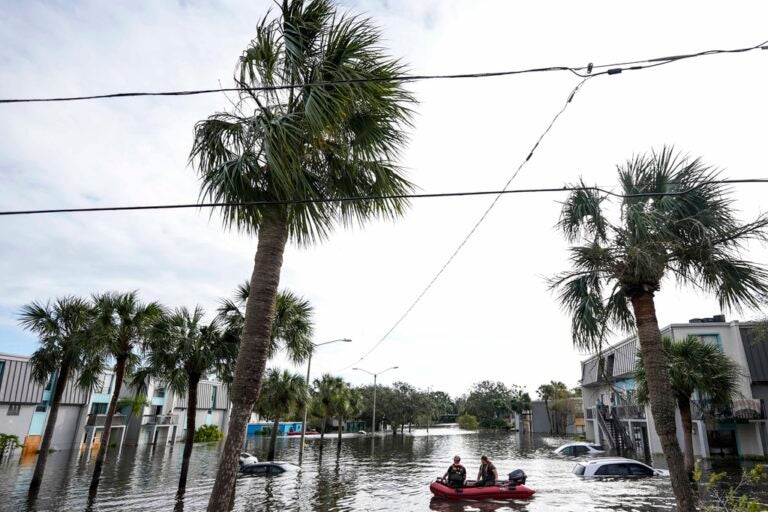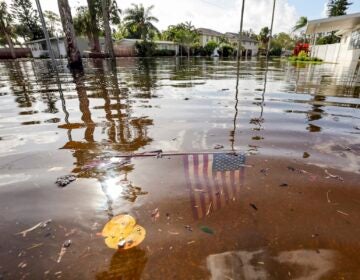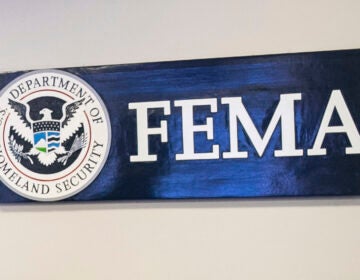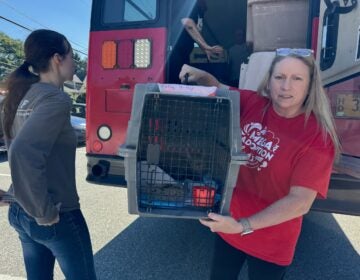What to know about Hurricane Milton after it slammed Florida’s Gulf Coast
Florida residents and officials were assessing the damage after powerful Hurricane Milton brought strong winds, heavy rains and tornadoes.

A water rescue boat moves in flood waters at an apartment complex in the aftermath of Hurricane Milton, Thursday, Oct. 10, 2024, in Clearwater, Fla. (AP Photo/Mike Stewart)
Florida residents and officials began assessing widespread damage Thursday after powerful Hurricane Milton brought strong winds, heavy rains and tornadoes as it moved toward the Gulf Coast and then barreled across the state.
Gov. Ron DeSantis told reporters that officials will have a better understanding of the extent of the damage as the day progresses. “The storm was significant but thankfully, this was not the worst-case scenario,” he said.
The storm has caused at least five deaths in a state where communities were still dealing with the damage from deadly Hurricane Helene two weeks ago.
The governor said the storm dumped up to 18 inches (45 centimeters) of rain in some areas, and officials reported completing dozens of high-water rescues.
Where did Milton make landfall and where did it go next?
Milton made landfall Wednesday evening as a Category 3 storm near Siesta Key, a barrier island of white sand beaches about 70 miles (112 kilometers) south of the Tampa Bay area.
While the Tampa Bay area, home to over 3.3 million people, was spared a direct hit, there was still flooding and damage there.
DeSantis said that Sarasota County, where Siesta Key is located, appears to have gotten the worst storm surge at 8 to 10 feet (2.5 to 3 meters). That is lower than the worst place during Helene though.
By early Thursday afternoon, Milton had weakened to a hurricane-force extratropical low and moved off Florida’s east coast.
How bad is the damage?
Officials in hard-hit Florida counties were urging people to stay home, warning of downed power lines, trees in roads, blocked bridges and flooding.
Before Milton even made landfall, heavy rain and tornadoes lashed parts of southern Florida, and over 100 homes were destroyed.
The Spanish Lakes Country Club near Fort Pierce, on Florida’s Atlantic Coast, was hit particularly hard, with homes destroyed and at least five people killed in tornadoes, the St. Lucie County Sheriff’s Office said.
The storm knocked out power across a large section of Florida, leaving over 3 million homes and businesses without electricity, according to poweroutage.us, which tracks utility reports.
In St. Petersburg, a crane working on a 46-story building toppled and a water main break led the city to shut down service. Also, the roof of the city’s Tropicana Field, home to the Tampa Bay Rays baseball team, was destroyed. Just inland from Tampa, the flooding in Plant City was “absolutely staggering,” according to City Manager Bill McDaniel.
Meanwhile, a manufacturer of IV fluids critical to hospitals nationwide said its Daytona Beach factory and distribution center were left intact after Milton.
Why are scientists saying this is an odd storm season?
Scientists say this is the weirdest storm season they have ever seen.
Beryl in July became the earliest storm on record to reach Category 5 status. Still, there was record quiet from Aug. 20 — the traditional start of peak hurricane season — to Sept. 23, according to Colorado State University hurricane researcher Phil Klotzbach.
Then five hurricanes popped up between Sept. 26 and Oct. 6, more than double the old record of two. On Sunday and Monday, there were three hurricanes at the same time, which had never happened before, Klotzback said.
In just 46 1/2 hours, Milton went from forming as a tropical storm with 40 mph winds to a top-of-the-charts Category 5 hurricane.
Some might wonder if it is possible to control extreme weather events. But scientists say hurricanes are too powerful for that, and climate change is providing more fuel than ever for storms like Helene and Milton.
What made Milton so unusual?
Warm water fueled rapid intensification that took Milton from a minimal hurricane to a massive Category 5 in less than 10 hours.
Milton also grew so potent because it avoided high-level cross winds that often decapitate storms, especially in autumn. As Milton neared Florida, it hit those winds and dropped in strength.
What if I have plans to vacation in Florida?
Three major theme parks in the Orlando area — Walt Disney World, Universal Orlando and SeaWorld — all closed as Milton approached but planned to reopen on Friday.
Orlando’s airport — the nation’s seventh busiest and Florida’s most trafficked — ceased operations as Milton threatened, as did Tampa International and nearby St. Pete-Clearwater International.
DeSantis said Thursday that the Tampa airport was repairing “minimal damage” and should reopen no later than Friday.

Get daily updates from WHYY News!
WHYY is your source for fact-based, in-depth journalism and information. As a nonprofit organization, we rely on financial support from readers like you. Please give today.





